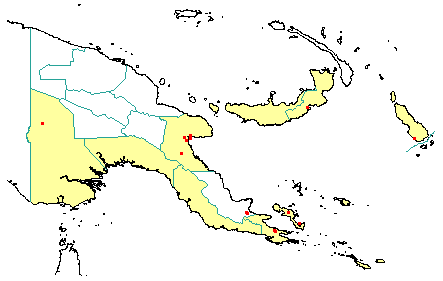
in PNGplants database
PNGTreesKey – Palaquium galactoxylum (F.Muell.) H.J.Lam var. salomonense (C.T.White) P.Royen |
Barry Conn (NSW) & Kipiro Damas (LAE).
Guide to trees of Papua New Guinea
Copyright held by the authors, National Herbarium of New South Wales, and Papua New Guinea National Herbarium
Blumea Vol. 10: 592 (1960)
Family: Sapotaceae
Dicotyledon
Timber Group: Commercial hardwood Tradename: Pencil Cedar
Field Characters: Large canopy tree (25-40 m high, rather taller); Bole cylindrical (30-100 cm diam.); straight (bole 20-27 m long); buttresses buttresses present (buttresses up to 2 m high); spines spines absent; aerial roots aerial roots absent; stilt roots stilt roots absent; Bark white, grey, or brown, rough, fissured; Subrhytidome (under-bark) green, red, or dark brown; less than 25 mm thick, 20.0-25.0; bark blaze consisting of one layer; faintly to non-aromatic; outer blaze pale yellow or slightly pink, markings absent; inner blaze pale yellow or slightly pink, markings absent; bark exudate (sap) present, white/milky, flowing, colour not changing on exposure to air, sticky; terminal buds not enclosed by leaves.
Indumentum: Complex hairs absent; stinging hairs absent; mature twig indumentum (hairs) present or absent, hairs sparse (hairs minute and appressed).
Leaves: Leaves clustered at end of branches, spiral (leaves occurring singly at a node and arranged spirally up the branchlet), simple (a leaf composed of a single blade); petiole present, not winged, attached to base of leaf blade, not swollen; leaves broadest above middle, 9.0-23.0 cm, 4.0-12.0 cm; symmetric, entire, not dissected or lobed, rounded, venation pinnate, secondary veins open, not prominent, but visible, intramarginal veins absent; leaves lower surface pale green or pale brown, upper surface green, indumentum (hairs) absent (by misinterpretation) or present, indumentum (hairs) dense or sparse (hairs minute and appressed); absent; domatia absent; stipules absent.
Flowers: Inflorescence axillary (usually below leaves) or on the trunk or branches, flowers single (appearing clustered because internodes short and occurring below leaves) or usually flowers arising from a single point, cones absent; flowers bisexual, stalked, flowers with many planes of symmetry, 9.0-11.0 mm long, diameter small (up to10 mm diam.); perianth present, with distinct sepals and petals whorls, inner perianth pale green; 6, some or partly joined; stamens 6, present, free of each other, joined to the perianth; ovary superior, carpels joined (when more than one), locules 6; styles solitary, 1.
Fruits: Infrutescence single, fruit 25.0-30.0 mm long, green (dark (possibly immature), not spiny, fleshy, simple, indehiscent, berry; seeds 1-2, to about 5 mm long (2-2.5 mm long), not winged, broad (as wide as long) (laterally compressed), seed 1-10 mm diam. (1-1.5 mm diam.).
Distribution: Morobe, Western, Gulf, Central, Milne Bay, Papuan Islands, New Britain & Bougainville.
 | Botanical records in PNGplants database |
Notes: Notes Two varieties are recognised, namely Palaquium galactoxylum var. galactoxylum which is restricted to Australia and var. salomonense (C.T.White) P.Royen. Palaquium galactoxylum var. galactoxylum has petioles 3-8 mm long, whereas var. salomonense has petioles 8-25 mm long.